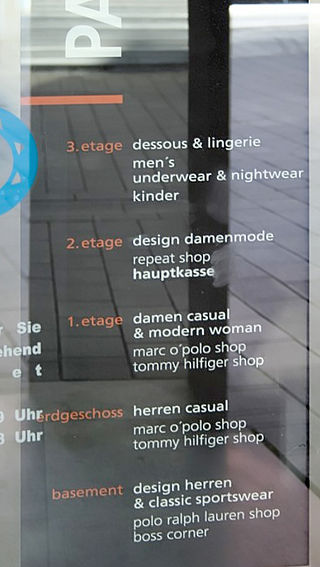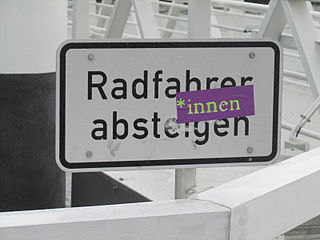
Austrian German, Austrian Standard German (ASG), Standard Austrian German, Austrian High German, or simply just Austrian, is the variety of Standard German written and spoken in Austria and South Tyrol. It has the highest sociolinguistic prestige locally, as it is the variation used in the media and for other formal situations. In less formal situations, Austrians use Bavarian and Alemannic dialects, which are traditionally spoken but rarely written in Austria. It has been standardized with the publishing of the Österreichisches Wörterbuch in 1951.

German is a West Germanic language in the Indo-European language family, mainly spoken in Western and Central Europe. It is the most widely spoken and official or co-official language in Germany, Austria, Switzerland, Liechtenstein, and the Italian province of South Tyrol. It is also an official language of Luxembourg and Belgium, as well as a recognized national language in Namibia. There further exist notable German-speaking communities in France (Alsace), the Czech Republic, Poland, Slovakia, Denmark, Romania and Hungary (Sopron).

Old Prussian was a West Baltic language belonging to the Baltic branch of the Indo-European languages, which was once spoken by the Old Prussians, the Baltic peoples of the Prussian region. The language is called Old Prussian to avoid confusion with the German dialects of Low Prussian and High Prussian and with the adjective Prussian as it relates to the later German state. Old Prussian began to be written down in the Latin alphabet in about the 13th century, and a small amount of literature in the language survives.
A pseudo-anglicism is a word in another language that is formed from English elements and may appear to be English, but that does not exist as an English word with the same meaning.
Standard High German (SHG), less precisely Standard German or High German, is the umbrella term for the standardized varieties of the German language, which are used in formal contexts and for communication between different dialect areas. German is a pluricentric Dachsprache with currently three codified specific national varieties: German Standard German, Austrian Standard German and Swiss Standard German.

Denglisch is a term describing the increased use of anglicisms and pseudo-anglicisms in the German language. It is a portmanteau of the German words Deutsch (German) and Englisch. The term is first recorded from 1965.
BRD is an unofficial abbreviation for the Federal Republic of Germany, informally known in English as West Germany until 1990, and just Germany since reunification. It was occasionally used in the Federal Republic itself during the early Cold War; it was commonly used between 1968 and 1990 by the ruling party of the German Democratic Republic, resulting in a strong deprecation of its use in West Germany. The East German regime had previously used the term "German Federal Republic", which it abbreviated as "DBR", to refer to West Germany. The most widely used abbreviation for West Germany in the country itself was its ISO 3166-1 alpha-2 country code "DE", which has remained the country code of reunified Germany.

The Duden is a dictionary of the Standard High German language, first published by Konrad Duden in 1880, and later by Bibliographisches Institut GmbH. The Duden is updated regularly with new editions appearing every four or five years. As of December 2020, it is in its 28th edition. It is printed as twelve volumes, with each volume covering different aspects of the German language such as loanwords, etymology, pronunciation, synonyms, etc.

The Deutsches Wörterbuch, abbreviated DWB, is the largest and most comprehensive dictionary of the German language in existence. Encompassing modern High German vocabulary in use since 1450, it also includes loanwords adopted from other languages into German. Entries cover the etymology, meanings, attested forms, synonyms, usage peculiarities, and regional differences of words found throughout the German speaking world. The dictionary's historical linguistics approach, illuminated by examples from primary source documents, makes it to German what the Oxford English Dictionary is to English. The first completed DWB lists over 330,000 headwords in 67,000 print columns spanning 32 volumes.
Low Prussian, sometimes known simply as Prussian (Preußisch), is a moribund dialect of Northern Low German that developed in East Prussia. Low Prussian was spoken in East and West Prussia and Danzig up to 1945. In Danzig it formed the particular city dialect of Danzig German. It developed on a Baltic substrate through the influx of Dutch- and Low German-speaking immigrants. It supplanted Old Prussian, which became extinct in the 18th century.

Konrad Alexander Friedrich Duden was a Gymnasium teacher who became a philologist. He founded the well-known German language dictionary bearing his name Duden.
Rudolf von Raumer was a German philologist and linguist, known for his extensive research of the German language. He was the son of geologist Karl Georg von Raumer.
Swiss Standard German, or Swiss High German, referred to by the Swiss as Schriftdeutsch, or German: Hochdeutsch, is the written form of one of four official languages in Switzerland, besides French, Italian, and Romansh. It is a variety of Standard German, used in the German-speaking part of Switzerland and in Liechtenstein. It is mainly written, and rather less often spoken.
The Österreichisches Wörterbuch, abbreviated ÖWB, is the official spelling dictionary of Standard German in Austria, i.e. of Austrian Standard German. It is edited by a group of linguists under the authority of the Austrian Federal Ministry of Education, Arts and Culture and contains a number of terms unique to Austrian German or that are more frequently used or differently pronounced there. A considerable amount of this "Austrian" vocabulary is also common in Southern Germany, especially Bavaria, and some of it is used in Switzerland as well. The most recent edition is the 44th from 2022. Since the 39th edition from 2001 the orthography of the ÖWB was adjusted to the German spelling reform of 1996.
A reverse dictionary is a dictionary alphabetized by the reversal of each entry:
The Deutsches Rechtswörterbuch (DRW) or Dictionary of Historical German Legal Terms is a historic legal dictionary developed under the aegis of the Heidelberg Academy of Sciences and Humanities. The research unit took up work in 1897 and until today has completed 93,155 articles, ranging from Aachenfahrt to selbzwölft. These have been published in 12 consecutive volumes and are also freely accessible online. In course of its research, the DRW also touches upon sources in Old English, of Hanseatic provenance and Pennsylvania German. The research unit will presumably conclude its work in 2036.

In German, a medial capital I is a non-standard, mixed case typographic convention used to indicate gender inclusivity for nouns having to do with people, by using a capital letter 'I' inside the word surrounded by lower-case letters. An example is the word LehrerInnen. With a lower case I in that position, Lehrerinnen is just the standard word for "female teachers".

The gender star is a nonstandard typographic style used by some authors in gender-neutral language in German. It is formed by placing an asterisk after the stem and appending the feminine plural suffix "-innen". For example, Fahrer becomes Fahrer*innen (drivers). The gender star makes it possible to refer to all genders while also including non-binary people.
Wolfgang Pfeifer was a German scholar and linguist.








